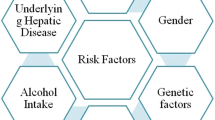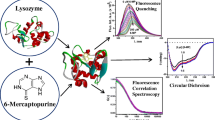Summary
Interactions between bile salts and cellular constituents are of considerable significance in studies on cholestasis. The main points of interest are the effects of the various bile salts on lipid and protein structures. Of primary interst are the interactions with lipids since these can cause disorder in cellular metabolism by eliminating compartmentalization. Conformational changes of proteins can occur through interactions with bile salts. They can involve specific functions. Of special importance here are the enzymes, since these are decisive supportive agents in cellular processes.
In this paper, the effect of various bile salts on the activity of key hepatic enzymes was studied. In addition to the kinetic tests for enzyme activity, structural changes of the enzymes were studied as well using electrophoretic techniques. It could be shown that even much lower bile salt concentrations than those which occur in bile can lead to a complete inhibition of activity. The varying sensitivities of different enzymes when they react in the presence of bile salts is striking. According to the degree of hydroxylation, the various bile salts show characteristic differences in inhibitory effect on enzymatic activity.
On the basis of the results reported here, it is quite possible that the interaction between bile salts and enzymes is a participating factor in the etiology and pathogenesis of cholestatic hepatic changes.
Zusammenfassung
Wechselwirkungen zwischen Gallensäuren und Zellbestandteilen sind im Zusammenhang mit Untersuchungen zur Cholestase von erheblicher Bedeutung. Schwerpunkte sind dabei die Wirkungen der verschiedenen Gallensäuren auf die Struktur von Lipiden und Proteinen. Die Wechselwirkungen mit Lipiden sind in erster Linie wegen der damit verbundenen Störung der Membranstruktur von Bedeutung, die den Zellstoffwechsel durch Aufhebung der Kompartimentierung in Unordnung bringen kann. Durch Wechselwirkungen mit Proteinen können Konformationsänderungen eintreten, die spezifische Funktionsleistungen in Mitleidenschaft ziehen. Von besonderer Wichtigkeit sind dabei Enzyme, da sie entscheidende Funktionsträger zellulärer Prozesse darstellen.
In der vorliegenden Arbeit wurde daher die Wirkung verschiedener Gallensäuren auf die Aktivität von Schlüsselenzymen der Leber untersucht. In kinetischen Tests wurden Enzymaktivitäten geprüft, mit elektrophoretischen Verfahren strukturelle Veränderungen an den Enzymen. Es konnte nachgewiesen werden, daß bereits weit niedrigere Gallensäurekonzentrationen als sie in der Gallenflüssigkeit vorkommen, bei gewissen Enzymen zu einem vollständigen Aktivitätsverlust führen. Es ist auffällig, wie unterschiedlich empfindlich verschiedene Enzyme auf die Anwesenheit von Gallensäuren reagieren. Die verschiedenen Gallensäuren zeigen je nach Hydroxylierungsgrad charakteristische Unterschiede in ihrer Hemmwirkung auf Enzymaktivitäten. Eine Beteiligung der Wechselwirkung zwischen Gallensäuren und Enzymen bei der Ätiologie und Pathogenese der cholestatischen Leberveränderungen erscheint aufgrund der hier ermittelten Resultate möglich
Similar content being viewed by others
References
Carey MC, Small DM (1972) Micelle formation by bile salts. Physical-chemical and thermodynamic considerations. Arch Intern Med 130:506–525
Erlinger S, Dhumeaux D (1974) Mechanism and control of secretion of bile, water, and electrolytes. Gastroenterology 66:281–289
Forker EL (1977) Mechanisms of hepatic bile formation. Ann Rev Physiol 39:323–345
Giblett ER (1976) Report of the Committee on Nomenclature. Cytogenet Cell Genet 16:65–74
Hanozet GM, Simonetta M, Gerola G (1976) Activation of rat liver alcohol dehydrogenase by deoxycholic acid. FEBS Lett 65:120–122
Hoffman NE, Donald D, Hofman AF (1975) The effect of bile acids on bile lipid secretion from perfused liver. Am J Physiol 229:714–721
Makino S, Tanford C, Reynolds JA (1973) The binding of deoxycholate and Triton X-100 to proteins. J Biol Chem 248:4926–4932
Miyai K, Price VM, Fisher MM (1971) Bile acid metabolism in mammals. Ultrastructural studies on the intrahepatic cholestasis induced by lithocholic and chenodeoxycholic acids in the rat. Lab Invest 24:292–301
Northfield TC, LaRusso NF, Hofman AF (1975) The effect of chenodeoxycholic acid treatment in gallstone subjects. Gut 16:12–18
Phillips MJ, Oda M, Mak E, Fisher MM, Jeejeebhoy KN (1975) Microfilament dysfunction as a possible cause of intrahepatic cholestasis. Gastroenterology 69:48–53
Stier A (1978) Membrane fluidity. In: Slater TF (ed) Biochemical mechanisms of liver injury. Academic Press, London, pp 319–364
Tanford C (1980) The hydrophobic effect: Formation of micelles and biological membranes. Wiley, New York
Author information
Authors and Affiliations
Additional information
Dedicated to Professor Dr. Leo Koslowski on the occasion of his 60th birthday
Supported by the Deutsche Forschungsgemeinschaft Schö 114/3-1 and Schm 192/10
Rights and permissions
About this article
Cite this article
Schmidt, K., Schölmerich, J., Ritter, H. et al. In vitro studies on the interaction between bile salts and key enzymes of the liver. Klin Wochenschr 60, 237–242 (1982). https://doi.org/10.1007/BF01728342
Received:
Accepted:
Issue Date:
DOI: https://doi.org/10.1007/BF01728342




